Plant Production Science
Development and systematization of production technology for crop cultivation based on improvement of productivity and environment conservation
Staff
Research Topics
Field crops such as rice, wheat, soybean, and corn are our research subjects. Through investigation of the growth process in crop plants, the eco-physiological characteristics of crops are clarified to improve the biomass production, yield, and quality of harvested products based on crop physiology and ecology. Our research projects are (1) elucidation of the mechanism of reproductive abortion in soybeans, (2) improvement of lodging tolerance in soybeans, (3) eco-physiological studies on organic rice culture, (4) improvement of nitrogen-use efficiency in rice varieties, and (5) the effects of global warming on the growth and yield of field crops.
Significance of flower differentiation and development in the yield determining process of soybean

Flowering habits and reproductive abortion were observed to elucidate the yield determining process of soybeans. To improve the lodging tolerance in soybean cultivars, the physical characteristics of the stem and root system involved in lodging were examined. |
Field survey of rain fed lowland rice cultivation in Southeast Asia

The field surveys have been conducted to establish stable rice production technology in rain fed lowland rice production in Southeast Asian countries. |
Ecological studies on organic rice culture

The effects of organic fertilization and pesticide application on the yield of rice were examined by a long-term (ten years) field trial. The structure and function of the rice paddy field ecosystem were elucidated through the investigation of occurrence of weeds, insects, small animals (zooplanktons) and microorganism. |
Design and evaluation of ideotype in high-yielding rice varieties

Clarifying the eco-physiological characteristics of rice varieties responsible for high-yield by modeling and simulation of rice canopy photosynthesis. We design and evaluate the rice ideotype. |
Clarification of matter-production process in crop pants

The differences in growth efficiency (net production / gross production) among crop species and varieties were examined to elucidate the effect of dark-respiration on dry-matter production. We evaluate the possible improvement of crop productivity through the control of dark-respiration. |
Improvement of nitrogen-use efficiency in field crops

For low-input sustainable rice production, the nitrogen use efficiency should be improved. High-yielding cultivars also showed higher nitrogen use efficiency with and without nitrogen application due to the higher sink formation capacity. |
Effect of global warming on crop productivity

The effect of rising temperatures on growth, yield and dry-matter production of rice, soybean, and wheat growing in the field during the whole growth period was examined in a temperature gradient chamber (TGC). High-temperatures seriously decreased the yield and grain quality in rice. |
The distribution, genetic diversity and starch-production potential of sago palm in Indonesia

The Sentani sub-district of Papua in Indonesia has about 4,000-5,000 hectares of sago palm natural forest. In Papua, sixty types of sago palm have been collected from the natural forest. The starch yield per trunk in Papua was highest 835 kg ever observed. |
Publication List
- Yabe, R., Nguyen, Q. C., Trinh, T. S. and Saitoh, K.: Effects of different types of fertilizers and methods on dry matter production, yield and nitrogen use efficiency of rice cultivars under field conditions, Sci. Rep. Fac. Agric. Okayama Univ., 104, in press (2015)
- Tanabe, S., Saitoh, K. and Yamauchi, M. : Technical assessment of unpuddling direct seeding rice culture with subsequent flooding by using iron-coated seeds, Bull. Field Science Center, Fac. Agr., Okayma Univ., 35, 9-17 (2014) in Japanese
- Ishizuki, H., Kikukawa, H., and Saitoh, K. : Effect of shading and high-temperature treatments on thickness and appearance quality of brown rice and palatability of cooked rice –Comparisons between 2009 and 2010–, Jpn. J. Crop Sci., 82,242-251 (2013) in Japanese
- Ishizuki, H., Matsue, Y., Ogata, T. and Saitoh, K. : Effect of thickness and appearance quality of brown rice on palatability and physicochemical properties of rice grown under shading and high-temperature treatments, Jpn. J. Crop Sci., 82,252-261 (2013) in Japanese
- Saitoh, K., Nishimura, K. and Kitahara, T. Effect of lodging on seed yield of field grown soybean –Artificial lodging and lodging preventing treatments–, Jpn. J. Crop Sci., 81,27-32 (2012) in Japanese
- Oh-e, I., Saitoh, K. and Kuroda T. : Effects of high temperature on growth, yield and dry-matter production of rice grown in the paddy field, Plant Production Science, 10, 412-422 (2007).
- Oh-e, I., Uwagoh, R., Jyo, S., Kurahashi, T., Saitoh, K. and Kuroda, T. : Effect of rising temperature on flowering, pod set, dry-matter production and seed yield in soybean, Jpn. J. Crop Sci., 76,433-444 (2007) in Japanese